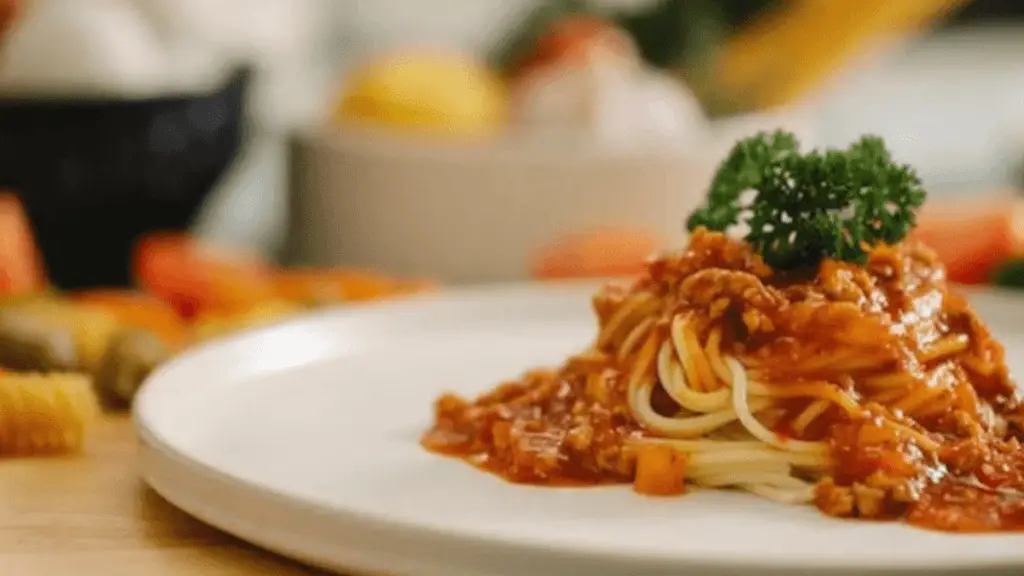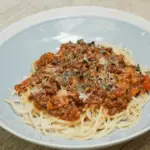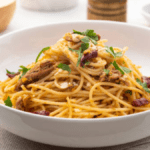Indulge in the mouthwatering flavors of authentic Italian Spaghetti recipe with this easy to follow recipe. Cooked al dente and coated in a savory tomato sauce enriched with garlic oregano and basil this classic dish is sure to transport you straight to Italy. Enjoy a delightful pasta experience garnished with Parmesan cheese and fresh basil leaves.
Here’s a classic Italian Spaghetti recipe
Ingredients
12 ounces (340g) spaghetti
2 tablespoons olive oil
4 cloves garlic, minced
1 can (28 ounces) crushed tomatoes
1 teaspoon dried oregano
1 teaspoon dried basil
1/4 teaspoon red pepper flakes (optional, for heat)
Salt and black pepper to taste
Grated Parmesan cheese for serving
Fresh basil leaves for garnish (optional)
Instructions
1/ Cook the spaghetti in a large pot of salted boiling water according to the package instructions until al dente. Drain and set aside, reserving about 1/2 cup of pasta water.
2/ In a large skillet or saucepan, heat the olive oil over medium heat. Add the minced garlic and sauté for about 1 minute until fragrant.
3/ Pour in the crushed tomatoes and stir in the dried oregano, dried basil, and red pepper flakes (if using). Season with salt and black pepper to taste. Lower the heat to a simmer and let the sauce cook for about 15-20 minutes, allowing the flavors to meld together.
4/ If the sauce becomes too thick, you can add a little bit of the reserved pasta water to reach your desired consistency.
5/ Once the sauce is ready, add the cooked spaghetti to the skillet and toss until the pasta is coated evenly with the sauce.
Serving Italian Spaghetti
Serve the Italian Spaghetti with Italian style with grated Parmesan cheese on top. You can also garnish with fresh basil leaves for an extra touch of flavor.
Enjoy your delicious homemade Italian spaghetti with friend or family.
Note: You can customize this Italian Spaghetti by adding cooked meatballs, sautéed vegetables, or other favorite toppings as desired.
Tips and Tricks to Make Delicious Italian Spaghetti

Al Dente Pasta: Cook the Italian spaghetti until it is “al dente,” which means it’s firm to the bite. Follow the package instructions and taste test the pasta a minute or two before the suggested cooking time. It should have a slight resistance when bitten.
Salt the Pasta Water: Add a generous amount of salt to the boiling water before cooking the spaghetti. It enhances the pasta’s flavor and ensures even seasoning throughout.
Sauce Consistency: If the tomato sauce is too thick, you can thin it out with a little pasta water. The starchy water will help the sauce cling better to the spaghetti.
Sautéed Garlic: Be cautious not to burn the minced garlic when sautéing it in olive oil. Burnt garlic can give a bitter taste, so cook it until it becomes fragrant and slightly golden.
Quality Tomatoes: Use high-quality crushed tomatoes or passata for the sauce. San Marzano tomatoes are highly regarded for their flavor and sweetness.
Seasoning: Taste the sauce while it simmers and adjust the seasoning to your liking. Add a pinch of sugar if the tomatoes are too acidic.
Fresh Basil: Adding some torn fresh basil leaves to the sauce right before serving enhances the dish’s aroma and taste.
Grated Parmesan: Serve the Italian spaghetti with freshly grated Parmesan cheese on top. It adds a rich, savory flavor to the dish.
Pasta Tongs or Fork: Use pasta tongs or a fork to toss the spaghetti in the sauce. It helps evenly coat the pasta without breaking it.
Garnish: For an attractive presentation, garnish the plated Italian Spaghetti with a sprig of fresh basil or a sprinkle of chopped parsley.
Experiment with Additions: Feel free to customize your Italian spaghetti with additional ingredients like sautéed mushrooms, olives, capers, or grilled vegetables for added texture and flavor.
Reheating: If you have leftovers, reheat the Italian spaghetti gently in a pan with a splash of water or sauce to prevent it from drying out.
Enjoy your delicious homemade Italian spaghetti.
NUTRITION FACTS

The nutrition facts for a serving of Italian spaghetti can vary depending on factors such as the portion size, the type of pasta, and the ingredients used in the sauce. Here’s a general overview of the nutritional information for a standard serving of cooked Italian spaghetti (about 2 ounces or 56 grams of dry pasta), without sauce:
Serving Size: Approximately 2 ounces (56 grams) of cooked spaghetti
Calories: Approximately 200-210 calories
Total Fat: Around 1 gram
Saturated Fat: About 0 grams
Trans Fat: Typically 0 grams
Cholesterol: Approximately 0 milligrams
Sodium: Roughly 0-5 milligrams (if cooked without added salt)
Total Carbohydrates: About 42-45 grams
Dietary Fiber: Around 2-3 grams
Sugars: Typically less than 1 gram
Protein: Approximately 7-8 grams
Keep in mind that these values are for plain cooked spaghetti without any sauce or toppings. If you add a sauce, meatballs, cheese, or other ingredients, the nutritional content will change accordingly.
For the most accurate nutrition information, it’s recommended to check the labels on specific pasta packages and sauce containers, or calculate the values based on the exact ingredients and serving size you use in your recipe. Additionally, whole wheat or whole-grain pasta will have slightly different nutrition facts, with more fiber and nutrients compared to traditional white pasta.






